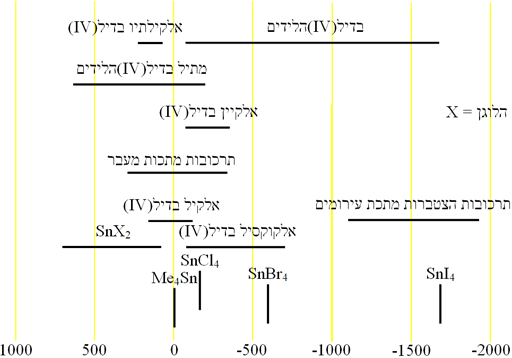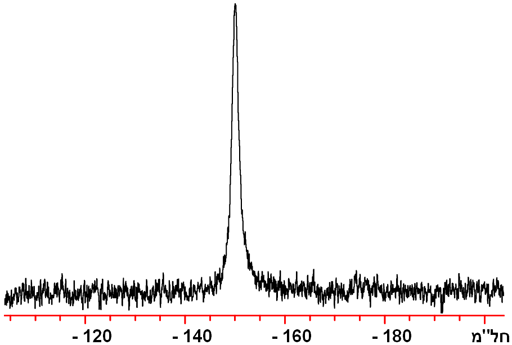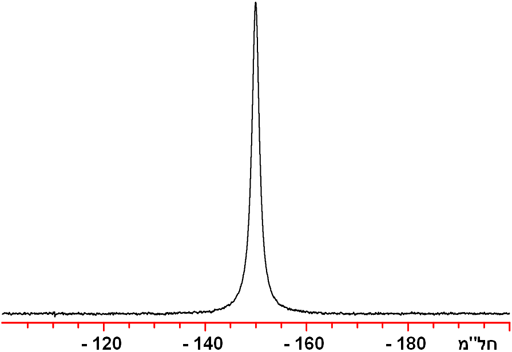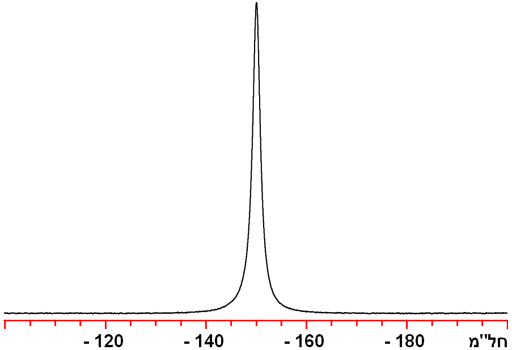תמג בדיל (Sn)
בדיל הוי יחודי משום שיש לו לא פחות משלושה גרעינים ספין חצי פעילי תמ"ג, 115Sn, 117Sn ו-119Sn, שנותנים סיגנלים חדים (תרשים 1) פרוס על תחום היסט כימי רחב מאוד. 119Sn קצת יותר רגיש מ-117Sn לכן 119Sn הוא הגרעינ המועדף בדרך כלל. 115Sn הרבה פחות רגיש מ-117Sn ו-119Sn. משתמשים בתמ"ג בדיל לחקור תרכובות אורגנובדיל אבל ניתן להשתמש בו לבדיל אורגנית.
תרשים 1. השוואה בין ספקטרה תמ"ג של האיזוטופים של בדיל 115Sn, 117Sn ו-119Sn עבור SnCl4 (טהור)

לכל סוג של בדיל יש טווח היסט כימי יחודי (תרשים 2).
תרשים 2. טווחי היסט כימי של תמ"ג בדיל

כל הגרעינים של בדיל מפוצלים על ידי גרעינים אחרים, דווח על צימוד ל-1H, 13C, 19F, 31P, וכו'. צימוד חד קשרי ל-13C בין 1200 ו-1500 הרץ. ל-1H צימוד החד-קשרי בין 1750 ו-3000 הרץ, ל-19F מ-130 ל-2000 הרץ ול-31P מ-50 עד 2400 הרץ. קבועי צימוד דו-קשרי בין בדיל לפרוטון בסביבות 50 הרץ. צימוד הומוגרעיני 119Sn-119Sn ובין-גרעיני 119Sn-117Sn דווחו בין 200 ו-4500 הרץ. לא דוחח על צימוד תלת- וארבע קשרי.
תמ"ג 115בדיל
115Sn הרבה פחות רגיש מאשר גרעינים אחרים של בדיל ולכן אינו הגרעין המועדף של בדיל. הוא גרעין ספין חצי שנותן סיגנלים חדים (תרשים 3).
תרשים 3. ספקטרה תמ"ג 115Sn של SnCl4 (טהור)

תכונות גרעין ה-115Sn
| תכונה | ערך |
|---|---|
| ספין | 1/2 |
| שכיחות בטבע | 0.34% |
| תחום ההיסט הכימי | 2600 ppm, בין -700 ל-1900 |
| יחס התדירויות (Ξ) | 32.718749% |
| חומר יחוס (נקודת אפס יחסית) | Me4Sn 90% ב-C6D6 |
| רוחב פס של חומר הייחוס | 2.7 הרץ |
| זמן התפוגה T1 של חומר הייחוס | שניות 0.65 |
| רגישות יחסית ל-1H בשכיחות טבעית | 1.24 × 10-4 |
| רגישות יחסית ל-1H כאשר מועשר | 0.0365 |
| רגישות יחסית ל-13C בשכיחות טבעית | 0.711 |
| רגישות יחסית ל-13C כאשר מועשר | 209 |
תמ"ג 117בדיל
117Sn קצת פחות רגיש מאשר 119Sn ולכן אינו הגרעין המועדף של בדיל בדרך כלל. הוא גרעין ספין חצי שנותן סיגנלים חדים (תרשים 4).
תרשים 4. ספקטרה תמ"ג 117Sn של SnCl4 (טהור)

תכונות גרעין ה-117Sn
| תכונה | ערך |
|---|---|
| ספין | 1/2 |
| שכיחות בטבע | 7.68% |
| תחום ההיסט הכימי | 2600 ppm, בין -700 ל-1900 |
| יחס התדירויות (Ξ) | 35.632259% |
| חומר יחוס (נקודת אפס יחסית) | Me4Sn 90% ב-C6D6 |
| רוחב פס של חומר הייחוס | 2.5 הרץ |
| זמן התפוגה T1 של חומר הייחוס | שניות 0.65 |
| רגישות יחסית ל-1H בשכיחות טבעית | 3.54 × 10-3 |
| רגישות יחסית ל-1H כאשר מועשר | 0.04615 |
| רגישות יחסית ל-13C בשכיחות טבעית | 20.8 |
| רגישות יחסית ל-13C כאשר מועשר | 271 |
תמ"ג 119בדיל
119Sn קצת יותר רגיש מאשר 117Sn והרבה יותר רגיש מ-115Sn, ולכן אינו הגרעין המועדף של בדיל בדרך כלל. הוא גרעין ספין חצי שנותן סיגנלים חדים (תרשים 5).
תרשים 5. ספקטרה תמ"ג 119Sn של SnCl4 (טהור)

תכונות גרעין ה-119Sn
| תכונה | ערך |
|---|---|
| ספין | 1/2 |
| שכיחות בטבע | 8.59% |
| תחום ההיסט הכימי | 2600 ppm, בין -700 ל-1900 |
| יחס התדירויות (Ξ) | 37.290632% |
| חומר יחוס (נקודת אפס יחסית) | Me4Sn 90% ב-C6D6 |
| רוחב פס של חומר הייחוס | 2.5 הרץ |
| זמן התפוגה T1 של חומר הייחוס | שניות 0.65 |
| רגישות יחסית ל-1H בשכיחות טבעית | 4.53 × 10-3 |
| רגישות יחסית ל-1H כאשר מועשר | 0.0527 |
| רגישות יחסית ל-13C בשכיחות טבעית | 26.6 |
| רגישות יחסית ל-13C כאשר מועשר | 310 |
מקורות
- D. E. Williams, L. H. Toporcer and G. M. Ronk, "Nuclear magnetic resonance coupling constants in tin in 3,3,3-trifluoropropyltin compounds", J. Phys. Chem., 74, 2139-42 (1970).
- E. V. Van den Berghe and G. P. Van der Kelen, "Study of the chemical bond in (CH3)nSn(SCH3)4-n(n=0,1,2,3) by NMR proton, tin-119, and carbon-13 spectroscopy", J. Organometal. Chem., 26, 207-13 (1971).
- J. D. Kennedy, W. McFarlane and G. S. Pyne, "Effect of interbond angles at tin upon tin-119 chemical shifts in organotin alkane-α ,ω-dithiolates and some related compounds", Bull. Soc. Chim. Belg., 84, 289-298 (1975).
- J. D. Kennedy, W. McFarlane, G. S. Pyne, P. L. Clarke and J. L. Wardell, "Magnetic double resonance studies of tin-119 chemical shifts in compounds with tin-sulfur bonds and related species", J. Chem. Soc., Perkin Trans. 2, 1234-1239 (1975).
- T. N. Mitchell, "Substituent chemical shifts of the organotin moiety in compounds of the type RSnMenCl3-n(n = 0 to 3; R = n-alkyl)", Org. Magn. Reson., 8, 34-39 (1976).
- A. Tupciauskas, "Tin-119 NMR constants for organotin compounds with remote substituents", Lietuvos Fizikos Rinkinys, 17, 233-238 (1977).
- B. Wrackmeyer, "Carbon-13 and tin-119 NMR studies on alkynylstannanes", J. Organometal. Chem., 145, 183-188 (1978).
- T. N. Mitchell, and G. Walter, "Fourier transform nuclear magnetic resonance investigations of organotin compounds. Part 6. Tin-119 and carbon-13 nuclear magnetic resonance. Spectra of hexaorganoditins and octaorganotritins", J. Chem. Soc., Perkin Trans. 2, 1842-1827 (1977).
- R. Hani, and R. A. Geanangel, "Tin-119 NMR in coordination chemistry", Coordination Chem. Rev., 44, 229-246 (1982).
- D. Dakternieks, R. W. Gable, and G. Winter, "Tin-119 and carbon-13 NMR studies on tin(IV) xanthates", Inorg. Chim. Acta, 75, 185-188 (1983).
- K. Kobayashi, M. Kawanisi, T. Hitomi and S. Kozima, "Bonding isomers of triorganostannyl enolates analyzed by tin-119 NMR spectroscopy", Chem. Lett., 497-500 (1984).
- H. Killing, H. and T. N. Mitchell, "New tin heterocycles: adducts between acetylenes or allenes and 'distannacyclopropanes'" Organometallics, 3, 1917-1919 (1984).
- A. Lycka, M. Nadvornik, K. Handlir, and J. Holecek, "Carbon-13 and tin-119 NMR spectra of some triphenyltin 4-substituted benzoates dissolved in coordinating and non-coordinating solvents", Coll. Czech. Chem. Comm., 49, 2903-2911 (1984).
- T. Yano, K. Nakashima, J. Otera, and R. Okawara, "Tin-119 NMR spectroscopic study on tetraorganodistannoxanes", Organometallics, 4, 1501-1503 (1985).
- J. Bluemel, and F. H. Koehler, "Direct and indirect metallation of endo-dicyclopentadiene. Tin-119 and carbon-13 NMR studies of stannylated derivatives", J. Organometal. Chem., 340, 303-315 (1988).
- T. N. Mitchell, J. C. Podesta, A. Ayala, and A. B. Chopa, "Experimental test of Karplus-type relationships for 3J(tin, carbon) and 3J(tin, hydrogen)", Magn. Reson. Chem., 26, 497-500 (1988).
- I. Wharf, "Studies in aryltin chemistry. Part 5. Tin-119 and carbon-13 NMR spectra of some tetra- and triaryltin compounds", Inorg. Chim. Acta, 159, 41-48 (1989).
- F. Thunecke, and R. Borsdorf, "Tin-119 NMR spectroscopic investigations of tributyltin derivatives of aromatic sulfonic acids", J. Prakt. Chem., 333, 489-494 (1991).
- J. McManus, D. Cunningham, and M. J. Hynes, "Nuclear magnetic resonance and structural investigations of the chemistry of organotin compounds. II. 119Sn NMR investigations of the pyrazine adducts of dialkyltin(IV) dihalides", J. Organometal. Chem., 468, 87-92 (1994).
- B. Wrackmeyer, M. Vosteen, and W. Storch, "Precise measurements of 115/117/119Sn NMR frequencies and first observation of isotope-induced chemical shifts 1Δ 117/119Sn(15N), 1Δ 115/119Sn(15N), and 2Δ 117/119Sn(29Si) in N-trimethylstannyl amines", J. Mol. Struct., 602-603, 177-184 (2002).
בטיחות
הוראת בטיחות: חלק מהחומרים המוזכרים כאן מסוכנים מאוד, יש להתייעץ עם נאמן בטיחות או כימאי לפני העבודה אתם . כאשר החומרים אינם מוכרים על נאמן הבטיחות או הכימאי לחפש בספרות המקצועית מידע בקשר אליהם. הממסים המשמשים לבדיקות תמ"ג הם ברובם דליקים ורעילים. TMS לדוגמא רעיל ודליק, יש להשתמש בכפפות ולעבוד במנדף. בחיוחד, בדיל עשוי להיות רעיל במנות גדולות. בדיל(IV)כלוריד מגיב בחריפות עם מים ופולט HCl רעיל ומאכיל.